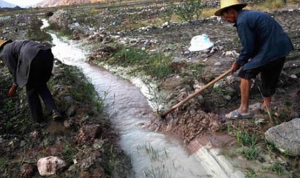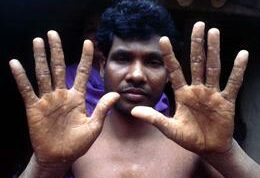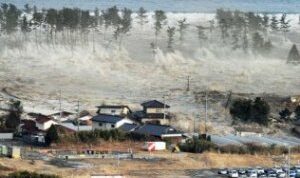 Soma. Dangerous levels of radiation leaking from a crippled nuclear plant forced Japan to order 140,000 people to seal themselves indoors on Tuesday after an explosion and a fire dramatically escalated the crisis spawned by a deadly earthquake and tsunami.
Soma. Dangerous levels of radiation leaking from a crippled nuclear plant forced Japan to order 140,000 people to seal themselves indoors on Tuesday after an explosion and a fire dramatically escalated the crisis spawned by a deadly earthquake and tsunami.
Prime Minister Naoto Kan told the country radiation had spread from the four stricken reactors of the Fukushima Dai-ichi nuclear plant along Japan’s northeastern coast. Two reactors exploded on Tuesday after days of frantic efforts to cool them.
Experts noted that much of the leaking radiation was apparently in steam from boiling water. It had not been emitted directly by fuel rods, which would be far more virulent, they said. “It’s not good, but I don’t think it’s a disaster,” said Steve Crossley, an Australia-based radiation physicist.
But France’s ASN nuclear safety authority said the nuclear accident at Tokyo Electric Power’s plant could now be classed as level six on an international scale of one to seven. Level seven was used only once, for the Chernobyl meltdown in Ukraine in 1986. The 1979 accident at the Three Mile Island nuclear power plant in the United States was rated a level five.
Chief Cabinet Secretary Yukio Edano said on Tuesday evening that radiation readings outside the reactors were falling below harmful levels. Earlier, he said the steel unit containing the radioactive core of one reactor had been damaged and warned of dangerous contamination.
The damage to the plant has come as a result of Friday’s devastating 9.0-magnitude quake and the ensuing tsunami that is thought to have killed well over 10,000 along Japan’s northeast coast, plunged millions into crisis and crippled the world’s third-largest economy.
The stock market plunged for a second day — by more than 10 percent — and a spate of panic buying saw stores run out of necessities. Asian and European stocks also dropped sharply, and US stocks opened about 2 percent down.
Though Kan urged calm, Tuesday’s developments fueled a growing panic in Japan and worldwide amid uncertainty over what would happen next. In the worst-case scenario, one or more of the reactor cores would completely melt down and spew large amounts of radioactivity into the atmosphere.
Winds were set to blow low-level radiation out over the Pacific Ocean on Tuesday night, easing health worries as they had been drifting toward Tokyo earlier on Tuesday, experts said.
“The cloud is going in the direction of Tokyo for the next 15 to 20 hours or so,” said Gerhard Wotawa, of the Austrian weather service ZAMG and an International Atomic Energy Agency adviser. “Then it will go out toward the Pacific. At some point this will also spread around the world.”
With prevailing winds, Canada and the United States might be first to detect a much diluted cloud. After the so far more serious 1986 Chernobyl disaster, radiation blew around the Northern Hemisphere in about three weeks. One UN study said Chernobyl may eventually be the cause of up to 9,000 deaths, mainly from extra cancers near the plant.
The radiation fears are adding to the catastrophe unfolding in Japan, where millions of people were facing a fifth night with little food, water or heating in near-freezing temperatures and snow as they dealt with the loss of homes and loved ones. As many as 450,000 people are in temporary shelters.
Officials have so far only been able to confirm about 3,300 killed. But those who were involved in the 2004 Asian tsunami said there was no question that more people died and warned that, like the earlier disaster, many thousands may never be found.
Officials said 70 workers were still battling the problems at the nuclear complex, all wearing protective gear and being rotated in and out of the danger zone quickly to reduce radiation exposure. Another 800 were evacuated.
Donald Olander, professor emeritus of nuclear engineering at University of California at Berkeley, said even the heavily elevated levels of radiation around Dai-ichi are “not a health hazard.” But without knowing specific dose levels, he said it was hard to make judgments. But they were nowhere near the levels released during Chernobyl.
On Three Mile Island, the radiation leak was held inside a containment shell — thick concrete armor surrounding the reactor. But the Chernobyl reactor had no shell and was also operational when the disaster struck. The Japanese reactors automatically shut down when the quake hit and are encased in containment shells.
Meanwhile, on Tuesday, a rare note of hope was struck as rescuers pulled a 70-year-old woman, Sai Abe, from her toppled home, five days after the tsunami tossed the house off its foundation.
Abe’s son said he had tried to save his mother but could not get her to flee from her home in the port town of Otsuchi. The woman was suffering from hypothermia when rescued and being treated in hospital.
Another survivor, described as being in his 20s, was pulled from a building further down the coast in the city of Ishimaki after rescue workers heard him calling.
Conditions for those still alive in the rubble worsened as a cold front arrived on Tuesday. Snow is forecast over the next few days.




